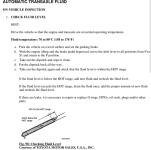2012 Highlander SE V6 2GR-FE:
I am experiencing difficulty in confirming if my transmission fluid level is accurate and would really appreciate any guidance.
I extracted around 4.20 quarts of ATF yesterday at 110°F. I replenished it with 4.2 quarts. Presented are images depicting the volume of fluid extracted, along with the dipsticks before and after, while the gearbox was heated.
Heated dipstick before to drain and fill (2 images):
Volume of ATF extracted:
Dipstick with the addition of 4.2 quarts of ATF WS (3 images):
The perplexing aspect for me is that I reintroduced about the same volume of fluid in a cold state as was extracted in a heated state, hence the dipstick reading should be elevated compared to the prior measurement. In this instance, it seems to be near the lower threshold of the chilly mark after the refill. The fluid level on the first dipstick reading before to the drain and fill seems to be far over the maximum hot mark. Is that typical? Am I misinterpreting this, or do I need to include more fluid?
The recommended fluid amount for this vehicle is between 3.7 and 4.2 quarts for a drain and fill, and around 9 to 9.8 gallons for a new gearbox. I extracted and introduced 4.2 quarts. Is there a discrepancy in volume between new and old ATF?
------------------------------------------
I opted to bring the car to the dealer for inspection, where the technician recommended against adding any more fluid, as the reading was satisfactory. He cautioned that excessive fluid may result in seal rupture. I am predisposed to heed his counsel and monitor the temperature to see whether it enters the perilous range. If that is the case, I would increase the fluid at that juncture; but, I am reluctant to proceed at this moment, since I have already added 4.2 quarts, which is the upper limit of the recommended range for a drain and fill.
I am experiencing difficulty in confirming if my transmission fluid level is accurate and would really appreciate any guidance.
I extracted around 4.20 quarts of ATF yesterday at 110°F. I replenished it with 4.2 quarts. Presented are images depicting the volume of fluid extracted, along with the dipsticks before and after, while the gearbox was heated.
Heated dipstick before to drain and fill (2 images):
Volume of ATF extracted:
Dipstick with the addition of 4.2 quarts of ATF WS (3 images):
The perplexing aspect for me is that I reintroduced about the same volume of fluid in a cold state as was extracted in a heated state, hence the dipstick reading should be elevated compared to the prior measurement. In this instance, it seems to be near the lower threshold of the chilly mark after the refill. The fluid level on the first dipstick reading before to the drain and fill seems to be far over the maximum hot mark. Is that typical? Am I misinterpreting this, or do I need to include more fluid?
The recommended fluid amount for this vehicle is between 3.7 and 4.2 quarts for a drain and fill, and around 9 to 9.8 gallons for a new gearbox. I extracted and introduced 4.2 quarts. Is there a discrepancy in volume between new and old ATF?
------------------------------------------
I opted to bring the car to the dealer for inspection, where the technician recommended against adding any more fluid, as the reading was satisfactory. He cautioned that excessive fluid may result in seal rupture. I am predisposed to heed his counsel and monitor the temperature to see whether it enters the perilous range. If that is the case, I would increase the fluid at that juncture; but, I am reluctant to proceed at this moment, since I have already added 4.2 quarts, which is the upper limit of the recommended range for a drain and fill.


